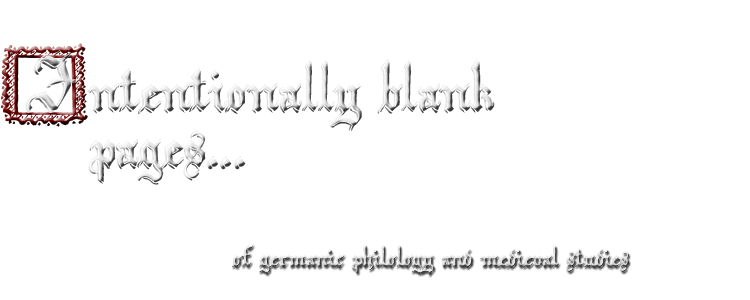The
origin of the gender system has always been - and still is - a very
uncertain field of studies, mostly because we can’t directly
observe its way of acting, but at best we can reconstruct it.
To
be able to analyze the development of English gender system we have
to take a step back to the Indo-European system – or better
Proto-Indo-European, as we are talking about a reconstructed language
–. We can briefly describe the Proto-Indo-European system as an
originally dual system, mostly based on the +animate/-animate
dichotomy. Eventually this system will evolve into a trial one which
is best known to us for its being composed by: masculine, feminine
and neuter. The connection between animacy and gender can be
explained in a simplistic way1
as animate > masculine, feminine (in which masculine can be seen
as the “strong” case and feminine as the “weak” one, because
it added a suffix to the substantive) and -animate > neuter. This
switching from one system to the other would eventually give birth to
a distinctive trait that Proto-Indo-European will pass to
Proto-Germanic and the other languages of its group: grammatical
gender. A system that uses grammatical gender can be distinguished
for the use of inflection: affixes were added to adjectives, nouns,
pronouns and determiners according to their gender.
Old
English as a Germanic language preserved this trait, in fact by
looking at these syntagms:
se
ealda
song
“the
old song”,
ealde
songas
“old
songs”;sēo ealde talu “the old tale”, ealda tala “old tales”;
þæt ealde scip “the old ship”, ealdu scipu “old ships”;
an Old English speaker could have said, without any doubt, that song was masculine, talu feminine and scipu neuter.
The peculiar thing about Old English is the fact that, at a certain point, this system decayed in favor of one that used natural gender. Although it is not possible to determine when exactly this phenomenon took place, we can find prominent traces in the “first continuation” of the Peterborough Chronicle2:
[…]
7 seo mynstre halgode seo ærcebiscop Deusdedit of Cantwarbyrig 7 seo
biscop of Rofecæstre Ithamar 7 seo biscop of Lundone þe wæs Wina
gehaten[…]
As
we can see in this portion of the entry 656 of the Chronicle, seo,
the feminine demonstrative, occurred with biscop
“bishop”
which
was originally masculine. The same thing happens with se
and fir
“fire”,
a masculine demonstrative with a neuter noun, as we can see in this
sentence from the entry 1122:
[…]
þa com se fir on ufenweard þone stepel […]
This
manuscript tells us that the change might have happened in the
East-Midlands around 1122-1131 A.D, or even slightly before that
period3.
It must be pointed out, however, that this kind of discrepancy
between natural and grammatical gender was already perceived during
the Old English period and expressed through the use of personal
pronoun in contrast to the grammatical gender of the noun.[…]Etað þisne hlāf, hit is mīn līchama […]
In this portion of Ælfric’s (c. 955 – c. 1010) Homilies, “hit” (neuter) is used in reference to “hlāf” “bread” (masculine).
As for the reasons why it took place, the answer is rather complicated. According to the traditional theory, the shifting from grammatical to natural gender in English was due to several distinct factors. On one side, during that time the language underwent through many simplifications: the rhizotonic nature of the language eventually led the weakening of unstressed vowels, moreover the OE determiner system (originally composed by se, seo, þæt) resulted in the uninflected form of þe. All these simplifications must have brought a great deal of confusion in the speakers’ mind.
On the other side the Norman Conquest brought about the condition for these irregularities4 to spread, English was in fact the language of uneducated people, and as such, was not subjected to control measures.
More recent studies have pointed out5 that natural gender should not be seen as a substitute to grammatical gender, as we have seen in the portion of Ælfric Homilies, they must have co-existed for a good deal of time, thus the cut-line between them must have been less tangible than we believe.
Bibliography
Croll Baugh, A., Cable, T., A History of the English Language, Taylor & Francis, Abington, 2005.Francovich Onesti, N., Digilo, M.R., Breve storia della lingua inglese, Carocci, Roma, 2005.
Gramley, S., The history of English, Routledge, London, 2012.
Luraghi, S., The origin of the Proto-Indo-European gender system: Typological considerations, <<Folia Linguistica>> 45, (2011).
Moore, S., Grammatical and natural gender in Middle English, <<PMLA>> 36, (1921).
Platzer, H., “No sex, please, we’re Anglo-Saxon?” On grammatical gender in Old English, <<VIEWS>> 10, (2001).
Shores, D.L., A descriptive syntax of the Peterborough Chronicle from 1122-1154, Walter de Gruyter, Berlin, 1971.
Smith, J., An Historical Study of English: Function, Form and Change, Routledge, London, 1996.
--------------------------------------------
1
For further information see S. Luraghi,
The
origin of the Proto-Indo-European gender system: Typological
considerations, <<Folia
Linguistica>> 45, (2011), pp. 435-438.
2
J. Smith,
An
Historical Study of English: Function, Form and Change,
Routledge, London, 1996, p. 147.
3
Note that this phenomenon might have taken place firstly in the
north, where inflections were already levelled because of the Norse
influence. See
A.
Croll Baugh, T. Cable, A
History of the English Language, Taylor
& Francis, Abington, 2005, p.
204.
4
See A.
Croll Baugh, T. Cable, A
History of the English Language, Taylor
& Francis, Abington, 2005, p. 205.
5
See H. Platzer,
“No
sex, please, we’re Anglo-Saxon?” On grammatical gender in Old
English, <<VIEWS>>
10, (2001), pp. 44-45.


Nessun commento:
Posta un commento